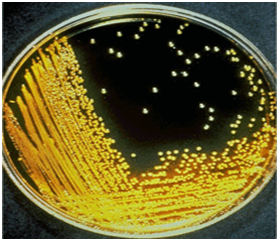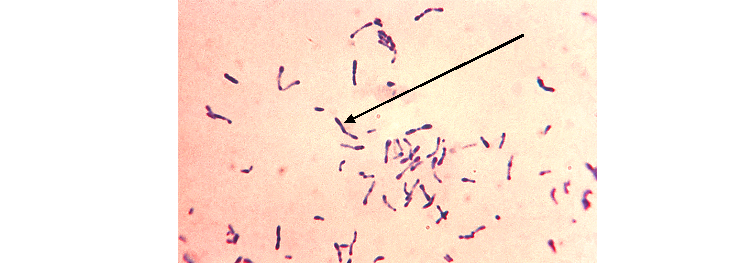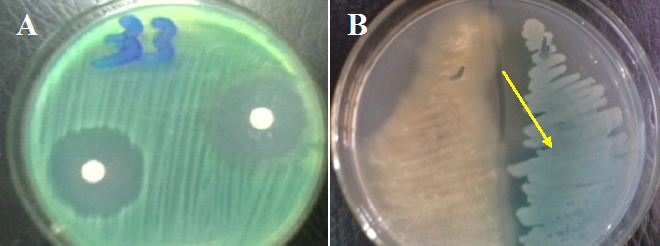Bacteriology is simply defined as the scientific study of bacteria. Pathogenic bacteriology thus, is the scientific study of bacteria that cause diseases in man. This unit which is one of the most important units of the clinical microbiology laboratory handles different types of patient’s specimens, with the sole aim of growing and isolating pathogenic bacteria from clinical specimens so that treatment can be properly administered by the physician. The proper and adequate isolation and growth of bacteria for which this unit is known for, are required before any biochemical tests can be used to confirm the identification of the pathogen isolated. It was said in the preceding pages of this book that the sole aim of the clinical microbiologist is to isolate and grow pathogens from host tissue and specimens so as to define the cause of an infectious disease which has taken hold of a patient.
The direct physical and microscopic examinations of the smears of patient’s specimens and other environmental samples cannot be sufficient enough to characterize and identify specifically the different species of microorganisms present in the sample. Thus it is paramount to undertake specific identification techniques in identifying the species of bacteria in the specimen using cultural technique. The presence of bacterial growth in the microbiology laboratory can be usually recognized by the development of colonies on solid media or turbidity/cloudiness in liquid media (broth). Cultivation is defined as the process of propagating/growing organisms (e.g. bacteria) in the laboratory by providing them with the proper and adequate environmental conditions needed for their growth. In a more general term, this process also means culture/culturing of microorganisms.
To grow or culture a microorganism simply means to make replicas of the microorganism, and doing this requires the microbiologist to provide all the needed nutrients with which the growth of the organism can be propagated. The technique of doing this in the laboratory is called culture technique, and this is one of the most significant techniques that differentiate the clinical microbiology laboratory from other laboratories like hematology and clinical chemistry in a hospital setting. It is a major technique in the clinical microbiology laboratory by which the causative agent of a particular disease can be defined. The culture of a microorganism is carried out in a solid or liquid medium which is totally made sterile (i.e. free from all microorganism). The culture media plate is then inoculated with a specimen or an organism and then incubated at a specific temperature and time that supports growth of the microorganism.
A pure culture (which is a culture that contains only a single kind of organism) which is usually free from any form of contaminating microorganism is finally recovered from the culture media plate after incubation. The isolated pure culture is then further tested biochemically and molecularly in order to identify and characterize them. Apart from demonstrating the presence of a pathogen which may be causing a particular disease or infection in a given human or animal host, the cultural technique in microbiology also helps to provide a platform via which microorganisms can be studied and identified in a more accurate way based on their different growth patterns on culture media.
Cultural techniques also enables colonies of pure bacterial growth to be isolated for further identification, biochemical, immunological, and antimicrobial susceptibility testing’s. The cultural technique is a prerequisite to giving a name to a microbe in the microbiology laboratory – since pure cultures (which are products of cultural techniques) are required for the proper identification and naming of isolated microorganisms. Microorganisms vary widely in their nutritional demands/requirements and their sources of metabolic energy. Thus, there are also a wide variety of media (microorganism’s food) available for the proper isolation of bacteria depending on the type of bacteria to be isolated. Commercially available culture media that are selective for particular organisms are available to isolate a given microbe from any environmental or clinical sample.
References
A Report from the American Academy of Microbiology (2008). Clinical Microbiology in the 21st Century: Keeping the Pace. American Academy of Microbiology, Washington D.C, USA.
Anaissie E.J, McGinnis M.R, Pfaller M.A (2009). Clinical Mycology. 2nd ed. Philadelphia, PA: Churchill Livingstone Elsevier. London.
Atlas R.M (2010). Handbook of Microbiological Media. Fourth edition. American Society of Microbiology Press, USA.
Balows A, Hausler W, Herrmann K.L, Isenberg H.D and Shadomy H.J (1991). Manual of clinical microbiology. 5th ed. American Society of Microbiology Press, USA.
Barrett J.T (1998). Microbiology and Immunology Concepts. Philadelphia, PA: Lippincott-Raven Publishers. USA.
Basic laboratory procedures in clinical bacteriology. World Health Organization (WHO), 1991. Available from WHO publications, 1211 Geneva, 27-Switzerland.
Beers M.H., Porter R.S., Jones T.V., Kaplan J.L and Berkwits M (2006). The Merck Manual of Diagnosis and Therapy. Eighteenth edition. Merck & Co., Inc, USA.
Berzofsky J.A and Berkower J.J (1999). Immunogenicity and antigen structure. In Fundamental Immunology, 4th edition., W.E. Paul, ed., Lippincott-Raven, Philadelphia
Biosafety in Microbiological and Biomedical Laboratories. 5th edition. U.S Department of Health and Human Services. Public Health Service. Center for Disease Control and Prevention. National Institute of Health. HHS Publication No. (CDC) 21-1112.2009.
Black, J.G. (2008). Microbiology: Principles and Explorations (7th ed.). Hoboken, NJ: J. Wiley & Sons.
Centers for Disease Control and National Institutes of Health (1999). Biosafety in Microbiological and Biomedical Laboratories, 4th edn, Washington DC: CDC.
Champoux J.J, Neidhardt F.C, Drew W.L and Plorde J.J (2004). Sherris Medical Microbiology: An Introduction to Infectious Diseases. 4th edition. McGraw Hill Companies Inc, USA.
Cheesbrough M (2010). District Laboratory Practice in Tropical Countries. Part I. 2nd edition. Cambridge University Press, UK.
Cheesbrough M (2010). District Laboratory Practice in Tropical Countries. Part 2. 2nd edition. Cambridge University Press, UK.
Discover more from Microbiology Class
Subscribe to get the latest posts sent to your email.





